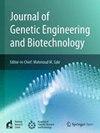揭示印度东部高原和丘陵地区尖葫芦(Trichosanthes dioica)基因型的遗传多样性:形态学和分子标记的见解
IF 2.8
Q3 Biochemistry, Genetics and Molecular Biology
Journal of Genetic Engineering and Biotechnology
Pub Date : 2025-07-19
DOI:10.1016/j.jgeb.2025.100542
引用次数: 0
摘要
尖葫芦(Trichosanthes dioica Roxb.)是一种原产于印度的营养丰富的雌雄异株瓜类作物,具有增强粮食安全的巨大潜力,但其遗传多样性仍未得到充分开发,限制了提高产量和质量的育种努力。本研究利用形态性状和ISSR标记对46个尖葫芦基因型的遗传多样性进行了评价。主成分分析(PCA)表明,3个主成分对总形态变异的贡献率为72.53%,其中果实重(0.47)、果肉重(0.46)和果实体积(0.44)是PC1的主要贡献率,而总果产量(0.53)和单株果数(0.49)是PC2的主要贡献率。PCA双图确定了五个不同的基因型组,突出了显著的多样性。对16个ISSR多态性标记进行分子分析,得到96个条带,其中76个(78.91%)为多态性,多态性信息含量(PIC)在0.35 ~ 0.47之间。聚类分析将基因型分为7个形态聚类和2个初级分子聚类,后者又分为6个亚聚类。Swarna Rekha、Swarna Suruchi、Swarna Alaukik、HAP 24、HAP 78和HAP 113被鉴定为高度多样化。这些发现表明,整合形态和分子标记有效地揭示了遗传变异,为育种计划提供了坚实的基础。未来的工作将集中在利用这些不同的基因型进行杂交,以开发高产、营养丰富的品种,并探索更多的分子标记,以进一步完善遗传多样性评估。本文章由计算机程序翻译,如有差异,请以英文原文为准。
Unravelling genetic diversity in pointed gourd (Trichosanthes dioica) genotypes from India’s Eastern plateau and hill region: Insights from morphological and molecular markers
Pointed gourd (Trichosanthes dioica Roxb.), a nutritionally rich, dioecious cucurbit crop native to India, holds immense potential for enhancing food security, yet its genetic diversity remains underexplored, limiting breeding efforts for improved yield and quality. This study addresses this gap by evaluating the genetic diversity of 46 pointed gourd genotypes using morphological traits and ISSR markers. Principal component analysis (PCA) revealed three principal components explaining 72.53% of the total morphological variation, with fruit weight (0.47), pulp weight (0.46), and fruit volume (0.44) as primary contributors to PC1, and total fruit yield (0.53) and number of fruits per plant (0.49) dominating PC2. The PCA biplot identified five distinct genotype groups, highlighting significant diversity. Molecular analysis with sixteen polymorphic ISSR markers generated 96 bands, of which 76 were polymorphic (78.91%), with Polymorphism Information Content (PIC) ranging from 0.35 to 0.47. Cluster analysis grouped genotypes into seven morphological and two primary molecular clusters, the latter further divided into six sub-clusters. Swarna Rekha, Swarna Suruchi, Swarna Alaukik, HAP 24, HAP 78, and HAP 113 were identified as highly diverse. These findings demonstrate that integrating morphological and molecular markers effectively uncovers genetic variability, providing a robust foundation for breeding programs. Future work will focus on leveraging these diverse genotypes for hybridization to develop high-yielding, nutrient-rich cultivars and exploring additional molecular markers to further refine genetic diversity assessments.
求助全文
通过发布文献求助,成功后即可免费获取论文全文。
去求助
来源期刊

Journal of Genetic Engineering and Biotechnology
Biochemistry, Genetics and Molecular Biology-Biotechnology
CiteScore
5.70
自引率
5.70%
发文量
159
审稿时长
16 weeks
期刊介绍:
Journal of genetic engineering and biotechnology is devoted to rapid publication of full-length research papers that leads to significant contribution in advancing knowledge in genetic engineering and biotechnology and provide novel perspectives in this research area. JGEB includes all major themes related to genetic engineering and recombinant DNA. The area of interest of JGEB includes but not restricted to: •Plant genetics •Animal genetics •Bacterial enzymes •Agricultural Biotechnology, •Biochemistry, •Biophysics, •Bioinformatics, •Environmental Biotechnology, •Industrial Biotechnology, •Microbial biotechnology, •Medical Biotechnology, •Bioenergy, Biosafety, •Biosecurity, •Bioethics, •GMOS, •Genomic, •Proteomic JGEB accepts
 求助内容:
求助内容: 应助结果提醒方式:
应助结果提醒方式:


